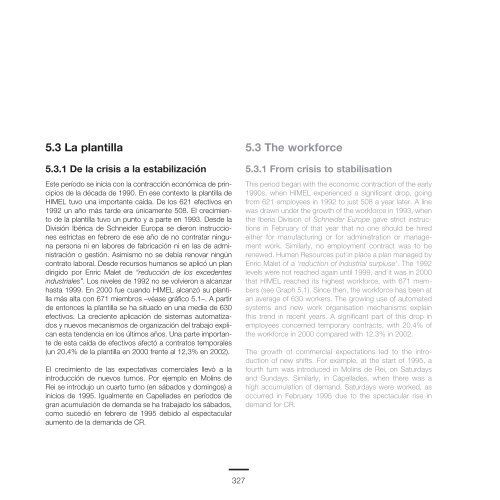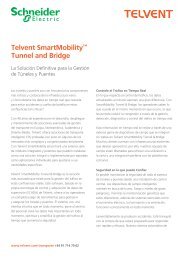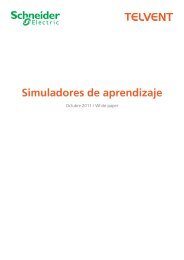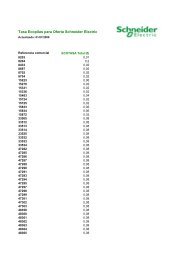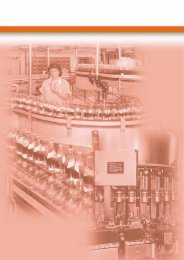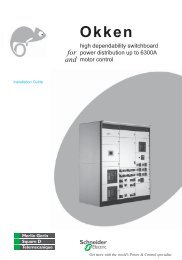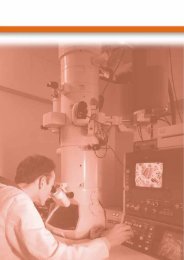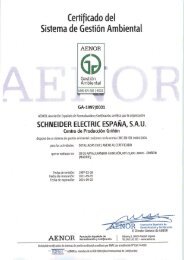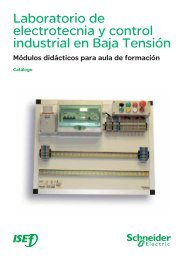Untitled - Schneider Electric
Untitled - Schneider Electric
Untitled - Schneider Electric
You also want an ePaper? Increase the reach of your titles
YUMPU automatically turns print PDFs into web optimized ePapers that Google loves.
5.3 La plantilla5.3.1 De la crisis a la estabilizaciónEste período se inicia con la contracción económica de principiosde la década de 1990. En ese contexto la plantilla deHIMEL tuvo una importante caída. De los 621 efectivos en1992 un año más tarde era únicamente 508. El crecimientode la plantilla tuvo un punto y a parte en 1993. Desde laDivisión Ibérica de <strong>Schneider</strong> Europa se dieron instruccionesestrictas en febrero de ese año de no contratar ningunapersona ni en labores de fabricación ni en las de administracióno gestión. Asimismo no se debía renovar ningúncontrato laboral. Desde recursos humanos se aplicó un plandirigido por Enric Malet de “reducción de los excedentesindustriales”. Los niveles de 1992 no se volvieron a alcanzarhasta 1999. En 2000 fue cuando HIMEL alcanzó su plantillamás alta con 671 miembros –véase gráfico 5.1–. A partirde entonces la plantilla se ha situado en una media de 630efectivos. La creciente aplicación de sistemas automatizadosy nuevos mecanismos de organización del trabajo explicanesta tendencia en los últimos años. Una parte importantede esta caída de efectivos afectó a contratos temporales(un 20,4% de la plantilla en 2000 frente al 12,3% en 2002).El crecimiento de las expectativas comerciales llevó a laintroducción de nuevos turnos. Por ejemplo en Molins deRei se introdujo un cuarto turno (en sábados y domingos) ainicios de 1995. Igualmente en Capellades en períodos degran acumulación de demanda se ha trabajado los sábados,como sucedió en febrero de 1995 debido al espectacularaumento de la demanda de CR.5.3 The workforce5.3.1 From crisis to stabilisationThis period began with the economic contraction of the early1990s, when HIMEL experienced a significant drop, goingfrom 621 employees in 1992 to just 508 a year later. A linewas drawn under the growth of the workforce in 1993, whenthe Iberia Division of <strong>Schneider</strong> Europe gave strict instructionsin February of that year that no one should be hiredeither for manufacturing or for administration or managementwork. Similarly, no employment contract was to berenewed. Human Resources put in place a plan managed byEnric Malet of a ‘reduction of industrial surpluse’. The 1992levels were not reached again until 1999, and it was in 2000that HIMEL reached its highest workforce, with 671 members(see Graph 5.1). Since then, the workforce has been atan average of 630 workers. The growing use of automatedsystems and new work organisation mechanisms explainthis trend in recent years. A significant part of this drop inemployees concerned temporary contracts, with 20.4% ofthe workforce in 2000 compared with 12.3% in 2002.The growth of commercial expectations led to the introductionof new shifts. For example, at the start of 1995, afourth turn was introduced in Molins de Rei, on Saturdaysand Sundays. Similarly, in Capellades, when there was ahigh accumulation of demand, Saturdays were worked, asoccurred in February 1995 due to the spectacular rise indemand for CR.327


